The Apple M1 processor is finally here, after years of speculation. It was obvious for a while that Apple would build on its success with in-house smartphone SoCs, but switching over from industry-standard Intel processors to custom ones is a huge step. Apple has smartly decided to ease into the transition by simply updating its existing products rather than launching all-new models that look completely different, ensuring that all focus is on the silicon. With a comprehensive and cohesive approach to software, many people might never even realise just how much has changed under the hood.
The new Mac mini is the first Apple desktop to get a new M-series processor, which makes sense since it’s the most affordable, versatile, and general-purpose model in the lineup. While Apple claims massive performance improvements compared to Intel-based models, this PC is at the bottom of the stack and isn’t likely to be used for heavy work where software and hardware compatibility are mission-critical. It also has a new lower starting price, which means it’s a little easier for people to get their hands on one for testing and experimentation.
I’ve been using the new Mac min with its M1 SoC for about a week, and I’ve found that there’s plenty to like, but it isn’t for everyone. Read on to see why.
Mac mini (M1, 2020) price and variants
Perhaps the biggest surprise about the new M1-based Mac mini is that it starts at $100 less than the previous Intel-based version. In India, the base variant with 8GB of RAM and a 256GB SSD costs Rs. 64,900 while doubling the storage to 512GB will raise the price to Rs. 84,900. It’s important to note that both RAM and storage are neither expandable nor replaceable so you have to consider how your usage will evolve over time.
Apple now offers customisation options in India through its online store and at authorised distributors. If you want your new Mac mini with 16GB of RAM, you’ll wind up paying Rs. 20,000 more. You can also choose a 1TB SSD for Rs. 40,000 over the base price, or a 2TB one for Rs. 80,000 more. These prices are frankly ludicrous, considering that you can buy a standard 1TB NVMe SSD for less than Rs. 10,000 today, but your only alternatives are external drives and cloud storage.
Despite Apple’s iron grip over its image, the company doesn’t sell matching monitors (other than the ultra-high-end 32-inch 6K Pro Display XDR) so you’ll need to buy your own. You could choose to buy Apple’s pricey Magic Keyboard, Magic Mouse 2 and/or Magic Trackpad 2, but oddly enough these aren’t offered as add-ons when configuring your Mac mini online.
Previous-gen Intel-based options remain available, but only as high-end configurations starting at Rs. 1,04,900 with a 3GHz 8th Gen Intel Core i5 CPU. This can be configured with up to a Core i7 CPU, 64GB of RAM and 2TB of storage, plus optional 10Gbit Ethernet. This is good news for people who use Mac minis as servers or in production environments.
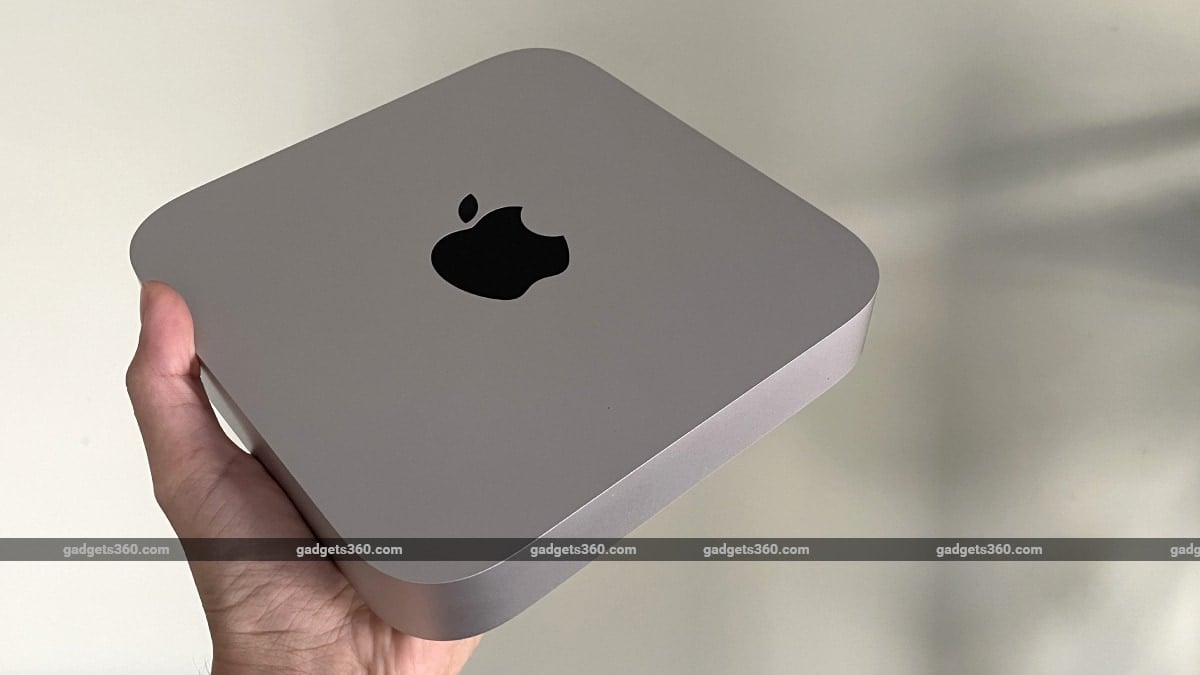
The M1-based 2020 Mac mini is exactly the same size and shape as the previous generation
Mac mini (M1, 2020) design
It’s not immediately obvious how to tell the new M1-based Mac mini apart from its predecessors. The most obvious clue is a return to silver aluminium after one generation of Space Grey bodies. If you look at the rear, you’ll also find only two Thunderbolt Type-C ports instead of the usual four.
The body is milled from a single block of metal. It’s just under 20cm square and 3.6cm tall, weighing 1.2kg. It can easily be tucked away in a corner, though it looks good enough and is unobtrusive enough that most people will want it on their tables. A VESA mount would have allowed this box to be hooked onto the back of most desktop monitors, but you’ll have to buy a third-party bracket if you want to do that.
The front is completely bare other than a tiny white power LED in the lower right corner. The power button is on the rear-right corner. All the ports are on the rear, and there’s a fairly decent selection by modern Mac standards – two USB 3.1 (5Gbps) Type-A ports, two Thunderbolt/USB4 (40Gbps) Type-C ports that also support video output, a standard HDMI 2.0 port, a 3.5mm audio socket, and Gigabit Ethernet. The power supply is integrated into the diminutive body so there’s also an AC power inlet and no external brick to deal with.
There’s also a fairly large vent on the rear. The Mac mini (M1, 2020) is actively cooled with a fan, unlike its sibling the new MacBook Air (M1, 2020) (Review). This makes sense for a desktop PC and also means that sustained performance over long periods should not be a problem.
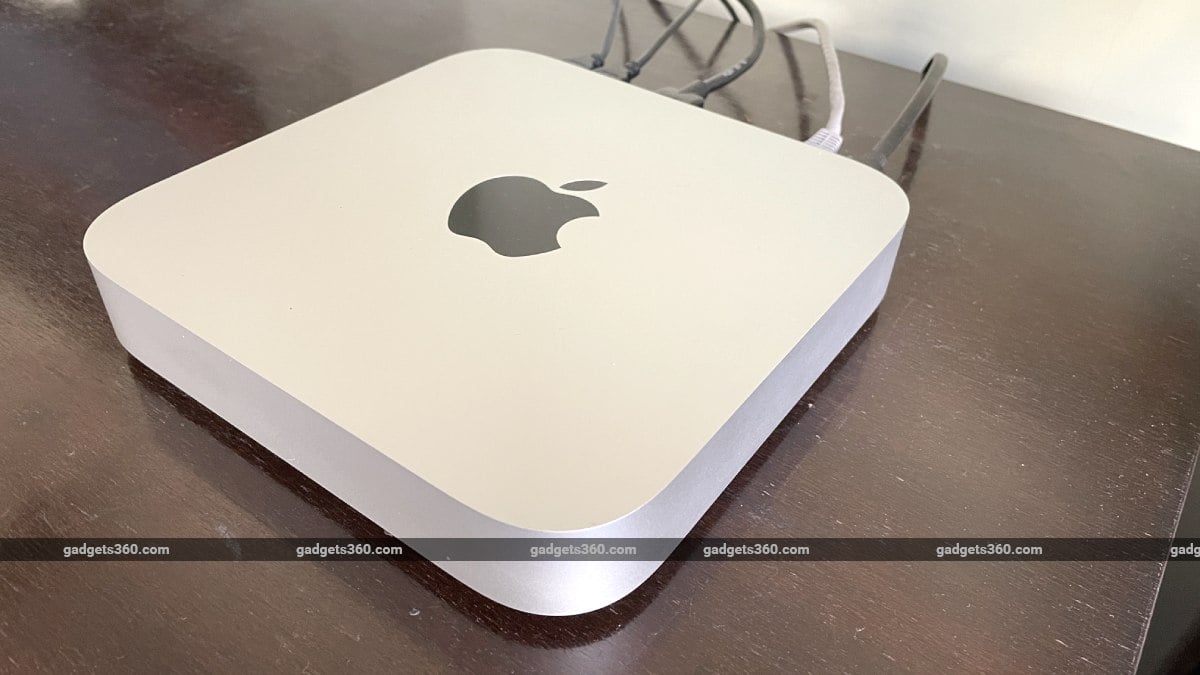
The Apple M1 SoC integrates CPU and GPU cores, AI logic, security, connectivity, and system RAM
Mac mini (M1, 2020) specifications
In the earliest days of personal computers, companies used commodity or custom-built CPUs from a variety of suppliers. As the IBM PC specification rose to dominance and most early computer brands went out of business or merged with one another, Intel’s x86 processors and the DOS/Windows operating systems became standard across the industry. That’s why nearly all computers have standard, interoperable hardware and software.
Apple, as usual the glaring exception to all trends and rules, used two entirely different architectures (Motorola 68000 and PowerPC) until market forces and faltering suppliers forced it to bend and move over to Intel CPUs in 2006. The transition wasn’t too rough, since Apple develops and controls its own operating system as well as plenty of popular software applications. A tool called Rosetta allowed older software to be “translated” on the fly, and people could for the first time run Windows easily and officially on Mac hardware without sluggish emulation. All in all, it was a good move at the time – but Apple does like to do things its own way.
Today, Apple is possibly the only company on the planet with the resources and willingness, as well as the user base, to justify ditching a common standard and going back to an era of fragmentation. After refining its in-house engineering talent with generation after generation of successful smartphone and tablet processors, Apple is betting big that it’s time to take the custom route with desktop and laptop PCs.
The new Apple M1 processor is, despite its rather unassuming name, a massive departure from Intel’s architecture. Apple claims the new Mac mini delivers up to 3X the CPU performance and 6X faster graphics than the previous generation, while adding its own Neural Engine subsystem for up to 15X faster machine learning. In laptops such as the new MacBook Air, it also delivers superior battery life.
The M1 includes four high-performance and four energy-efficient CPU cores, an integrated 16-core GPU, storage and IO controllers, security, and an image signal processor. Most interestingly, Apple has integrated DRAM right onto the SoC package giving all the various logic blocks equal access, which should boost speed and reduce latency.
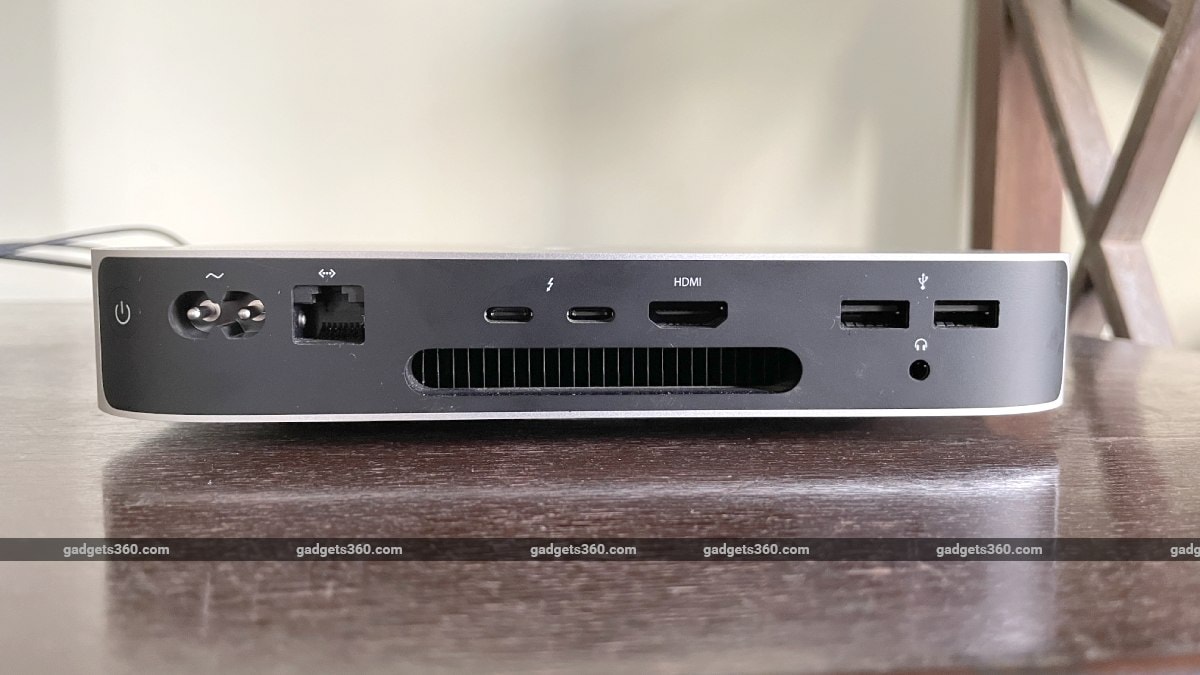
The Mac mini (M1, 2020) has only two Thunderbolt/USB4 ports, whereas the Intel-based model has four
Just like before, Apple has worked on its hardware and software together. MacOS 11 Big Sur is optimised for Apple Silicon, every in-house app has been prepared in advance, and Rosetta 2 will translate third-party software as and when needed.
The M1 SoC is a huge achievement for Apple, and this is just the first chapter of a much bigger transformation. At the end of the day though, the company clearly wants things to be business as usual for its end users – just another day, doing the same things, only a lot faster.
Beyond the processor, the latest Mac mini isn’t much different from its predecessors. RAM and storage aren’t upgradeable and it’s a pity that Apple won’t even allow for an additional internal SSD – even though the motherboard is smaller than before, leaving room in the chassis. There are pros and cons to this approach for ultraportable laptops, but there’s no reason for a desktop PC to be this constrained.
You get Wi-Fi 6 and Bluetooth 5, but no NFC or Ultra Wideband support, which Apple has built into all its latest laptops and portables for things like direction-aware AirDrop file transfers. There’s a built-in speaker which works for all audio, not just system-level beeps. One big limitation compared to the Intel-based Mac mini is that there are only two Type-C ports on the rear, rather than four. These support the Thunderbolt/ USB4 standards for up to 40Gbps data transfers.
You can connect one monitor going up to 6K in resolution to either Type-C port, and run a second 4K monitor over HDMI. Intel-based Macs can power up to three external displays and can also work with Thunderbolt eGPUs. Such use cases would be fairly niche, but it’s worth knowing that these limitations exist.
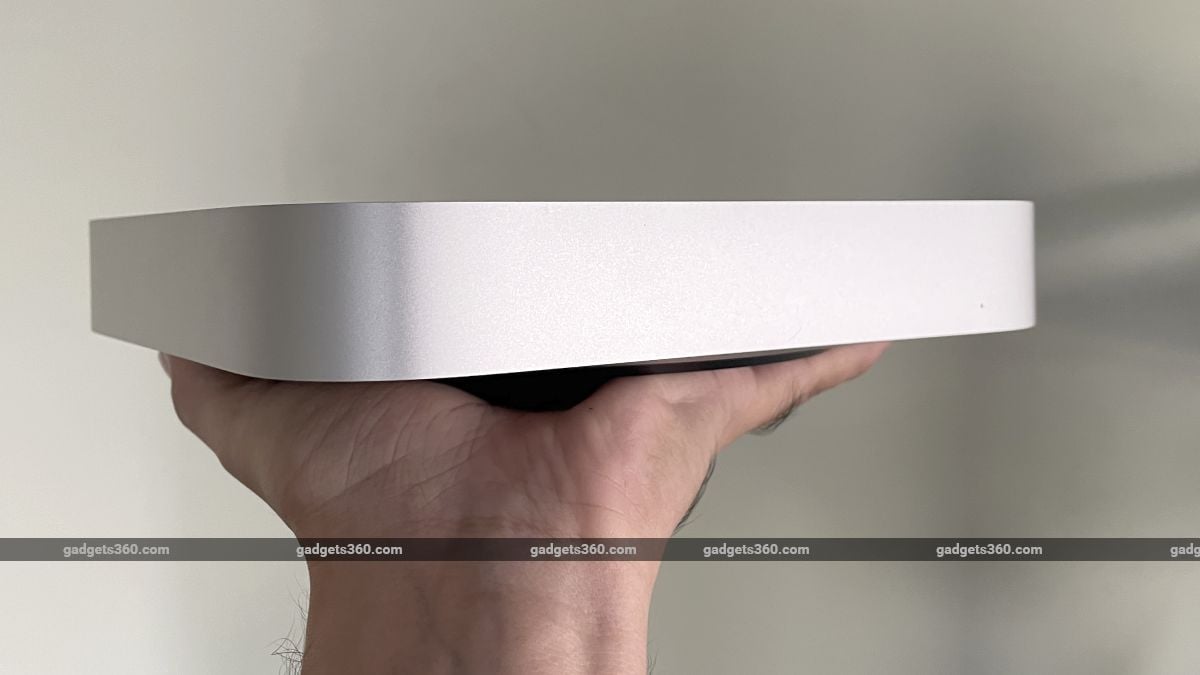
RAM and storage are completely non-upgradeable on the Mac mini (M1, 2020)
Mac mini (M1, 2020) software and performance
I set up the new Mac mini with a 4K Asus PB287Q monitor and a basic PC keyboard and mouse. This meant no keyboard shortcuts for things like adjusting the volume (without tweaking settings or downloading extra apps). The setup process was simple enough. You can choose whether or not to sign in with an Apple account, but you’ll have to sign in later if you want to use any Apple service or grab anything from the Mac App Store.
MacOS 11 Big Sur has received a massive facelift, with a completely fresh design style, tweaked window layouts, and several iOS-inspired touches such as widgets and quick toggles for settings. Everything runs smoothly and snappily on the new M1-based Mac mini. It’s exactly the same experience that you can expect on an Intel-based Mac, right down to the preinstalled apps.
Speaking of apps, there are quite a lot of them including GarageBand, iMovie, Pages, Numbers, Keynote, Apple Music, Apple TV, Time Machine, Books, Maps, Mail, and of course Safari, to name a few. All of them loaded very quickly. I had no trouble creating a project with multiple tracks and effects in GarageBand.
MacOS has absorbed plenty of features from iOS and iPadOS, but if you were worried about new Apple Silicon-based Macs turning into dumbed-down iPad-like machines, there’s no need to worry. Terminal, Automator, and other tools for power users are all accounted for.
One of the most significant features of Big Sur on M1-powered Macs is the ability to run iPhone and iPad apps, since the CPU architecture is now common across Macs and iOS devices. Not all apps are available in the Mac App Store, which makes sense to avoid duplication. Notably, apps that rely on tilt controls, cameras, AR, and the various sensors that you can take for granted in mobile devices are not available. Other familiar apps might show up with modifications once developers are sure the experience will be smooth.
This could make life easier for developers, but mobile apps do need some work to fit in with desktop UI optimisations such as resizable windows, keyboard shortcuts, and drag-and-drop support. You’ll find such apps under a separate tab in the Mac App Store, and many have faint text below their names letting you know that they are “Not verified for macOS” – so your mileage will vary, but things should improve over time.
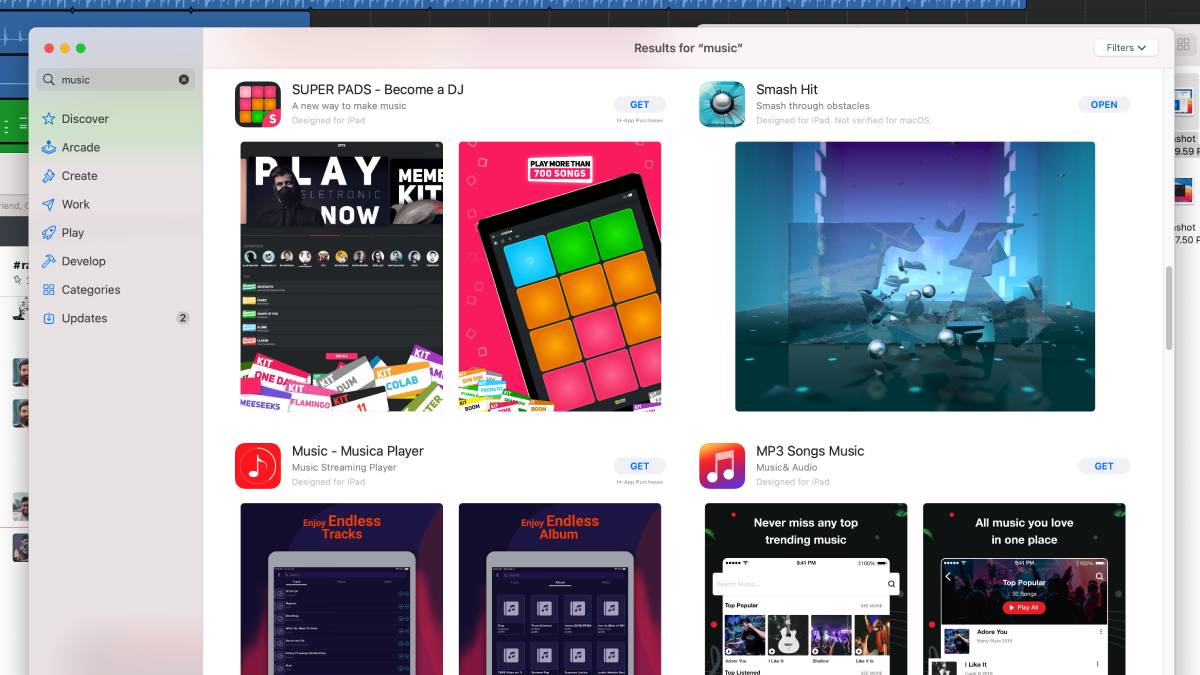
A very faint incompatibility disclaimer is displayed on some App Store search results
Of course there’s also plenty of legacy software that isn’t yet (or might never be) rewritten for Apple Silicon, and for those, there’s Rosetta 2. The first time I tried to run an older program, I saw a dialogue box prompting me to install Rosetta 2 first. This took barely a minute, and I wonder why it isn’t preinstalled and ready to go already, considering how essential it is. After that, I was able to install programs. There’s a slight delay while the background work of translating the software happens, and an indication on screen would have been helpful, because at first it seemed that the program was unresponsive.
I was able to install Steam, and through that, I downloaded and installed a few Mac-compatible games. There’s no distinction between Intel-based and M1-based Macs, since this is all brand new, but anything that worked before should work now. Shadow of the Tomb Raider was able to post a 25fps average at 1920×1080 using its Medium quality setting, which is pretty impressive for an integrated GPU. After reducing the quality to Low, the frame rate rose to a more comfortable 35fps average. Superhot and Civilization V also ran well at 1920×1080, and both were enjoyable – you’d never even know there was any possibility of incompatibility.
The Epic Games Store ran extremely poorly at first. The UI was horribly sluggish and it crashed a few times, but everything ran perfectly smoothly a day or two later, which might indicate that some background work was still going on. Simple games in my library, including Fez and FTL, ran perfectly well.
The Unigine Valley benchmark, also running through Rosetta 2, was a bit buggy at some settings but managed to run at 1920×1080 at Ultra quality with 4XAA, and posted a 26.5fps average.
Pro users might be wondering whether a Mac mini with an M1 SoC is good enough for heavy-duty workflows, considering Apple’s boasts of performance that outperforms most current-day PCs and higher-end Macs. In my brief experience, you should actually be able to do some serious video editing and graphics work. Final Cut Pro loaded quickly and ran smoothly, and video was encoded and exported in no time. I downloaded an M1-native Alpha build of Blender from Github and ran the standard BMW render benchmark, which took 5 minutes, 7.79 seconds to complete.
Browser-based benchmarks were impressive. The Mac mini (M1, 2020) scored 177.110 points in the Jetstream2 Javascript test, 855.37 in Basemark Web, and 286 in WebXprt. I used Blackmagic’s Disk Speed Test utility to check SSD performance and got read and write figures of 2,860.9MBps and 2,881.9MBps respectively. Using the latest development snapshot build of Handbrake, which now supports Apple Silicon, I was able to transcode a 1.3GB AVI file to H.265 in just 1 minute, 1 second.
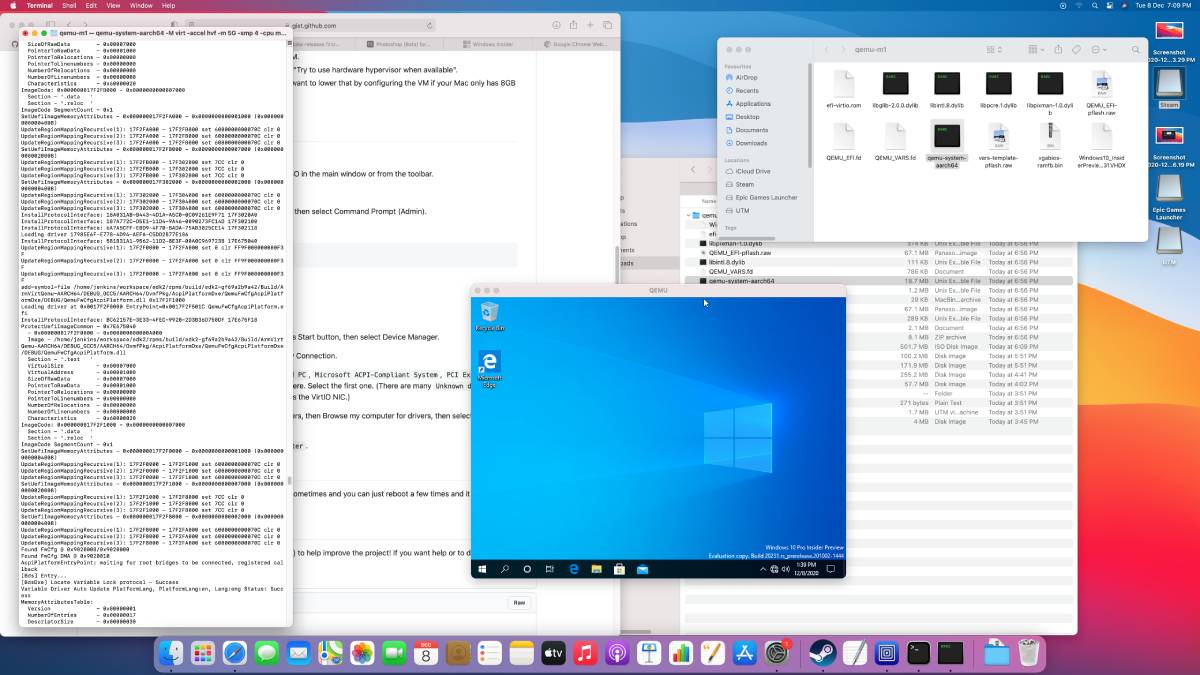
It takes some effort to get Windows 10 up and running in a virtualised environment
Windows on the Mac mini (M1, 2020)
One huge casualty of the move from x86 to ARM architecture is the fact that you can’t just install Windows 10 on M1-based Macs – at least not yet. Microsoft does develop Windows for ARM-based devices such as its own Surface Pro X so it shouldn’t be so tough to make it happen. If the two companies decide to keep working together as they have so far, we could see official support somewhere down the line.
At the moment, you can run ARM-specific Windows 10 on an M1-based Mac through virtualisation, which means that it runs as an application within macOS. A number of talented developers have already posted patches, drivers and instructions online. You’ll need to sign up for Microsoft’s Windows Insider beta programme, download the Windows 10 ISO, and follow the steps carefully.
I was able to run Windows through QEMU using the patches and macOS Terminal commands first posted by developer Alexander Graf. At first, you’ll get a 640×480-pixel window, and this can only be raised to 1024×768. Network drivers have to be obtained and installed manually if you want the virtualised OS to recognise an Internet connection. Other, more user-friendly GUI-based virtualisation tools have since been shown to work. Some users have also managed to run ARM-specific Linux distributions.
Keep in mind that Windows 10 on ARM has limitations of its own in terms of software support – it isn’t guaranteed that you’ll be able to run legacy Windows software without any hitches. Also, everything hinges on Microsoft allowing people to buy or license ARM-specific Windows 10 – so far it has only been available preinstalled on laptops with certain Qualcomm SoCs. If that doesn’t happen, people will be stuck with unofficial workarounds using potentially buggy beta versions.
There’s no telling how long we’ll have to wait to see how this situation plays out. It should suffice to say that if you currently use Windows for anything on a Mac, you’ll need to wait before switching over to Apple Silicon. On a sadder note, this is very likely the beginning of the end for the “hackintosh” movement – enthusiasts running macOS on commodity x86 PC hardware.
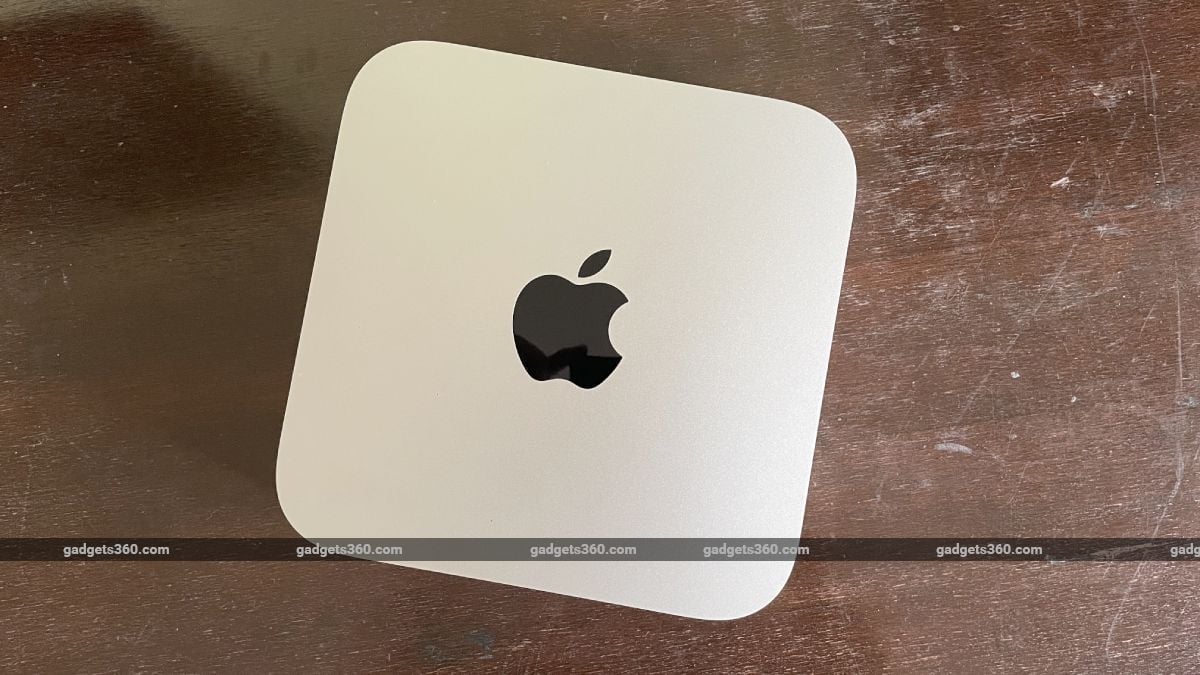
Apple will continue to sell and support Intel-based Macs for several more years
Verdict
The new Mac mini is deliberately familiar on the outside, and if you’re a casual user, you might never know how important and far-reaching the changes on the inside are. Apple could easily have designed an even smaller new Mac mini or even introduced a completely new kind of desktop to debut its M1 SoC but the whole point is to make it feel like there’s no transition at all. I have no doubt that much more exciting Macs in new form factors will be unveiled over the next year or two – an upgradeable yet affordable desktop would be very welcome, but we’ll have to wait and see.
On the bright side, you have a very snappy, responsive, and unobtrusive computer with a vast amount of software that’s ready to go. If you’re a home user and get most of your work done in a Web browser, or if your workflow revolves around Apple’s own creative and productivity tools, using the new Mac mini with its M1 SoC shouldn’t cause even a slight hiccup.
The bad news is that RAM and storage aren’t upgradeable and the limited options you get at the time of purchase are horrendously expensive. There are only two Thunderbolt/USB4 ports, and some niche external hardware is currently not supported. There’s no news about if or when Windows might be officially supported, and Pro users might want to wait a while for some software vendors (such as Adobe) to release M1-native updates – by which time newer and better Macs might be available. The Intel-based Mac minis that are currently on sale will be supported for years to come, but won’t be able to run iOS apps natively.
As for the M1 SoC, this rollout is a resounding success for Apple. No other company could pull this off – Microsoft and Qualcomm have tried with Windows on ARM, Google has tried with Chrome OS – and the computer industry will never be the same. I can’t wait to see how the more powerful iMac and Mac Pro (or their successors) with future Apple Silicon SoCs will turn out.
Apple Mac mini (M1, 2020)
Price: Rs. 84,900 (as reviewed)
Pros
- Very good performance
- Backward software compatibility
- Compact and quiet
- Built-in power supply
- Lower starting price
Cons
- RAM and storage not upgradeable
- Limited, expensive configuration options
- Only two Thunderbolt/USB4 ports
Ratings (out of 5)
Design: 4
Performance: 4.5
Software: 4
Value for Money: 4.5
Overall: 4.5
This article was originally published by Ndtv.com.
